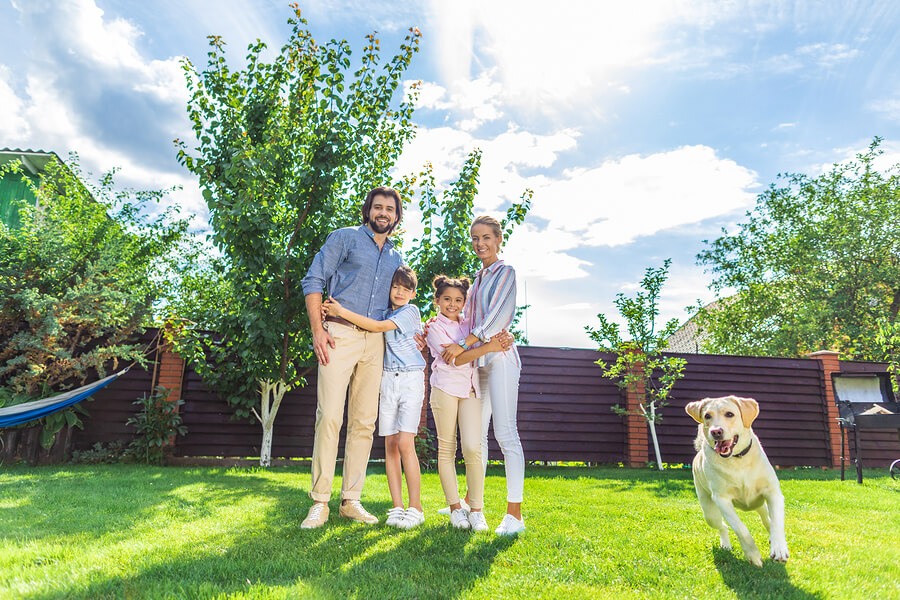Can you make your dog and lawn coexist? Well, it’s a question many pet owners have, particularly those who really care about their landscaping and their furry family members. There are nearly 43.35 million households with dogs, averaging 1.6 canines per home, or about 36.5 percent of all homes in the United States, according to the American Veterinary Medical Association.
We love our pets and there’s plenty reason why. Dogs provide unconditional love, a whole lot of cuddly companionship, and even household and personal protection. But what about the dreaded brown spots left on your lawn? You try so hard to keep the grass well maintained, green and nicely cut, but still, you’re battling your dog’s call to nature, especially when it comes to urine. The good news is, yes, you dog and lawn can coexist.
About those Lawn Brown Spots
There are plenty of unexpected landscape, outdoor living costs, but this isn’t one many homeowners really think about. When you adopt or rescue a puppy or dog, you don’t really consider how it’s natural bodily function will interact with your lawn. That is, until you begin to see brown spots dotting your grass, here and there. These are usually attributed to “acid” in a dog’s urine, but that’s not actually the case. It’s the nitrogen which is produced due to protein breakdown of a canine’s diet.
Dog owners usually love having big yards where their pups can enjoy romping through the grass. Unfortunately, you may have noticed that it’s not always easy to keep your lawn green after Lassie does her business. Getting doused in dog urine can be a death sentence for your lawn, but there are actually several ways to prevent your pup from killing the grass. —Dog Food Insider
A dog’s diet is high in protein because it’s what helps to keep healthy. And, a lot of protein means a whole lot of nitrogen — quite similar to those nitrogen-rich liquid fertilizers so commonly found at seed and feed stores and home improvement retailers. While your lawn does need nitrogen to keep the grass healthy, it only needs a certain amount. Too much nitrogen will damage and eventually kill your grass.
How to Make Your Dog and Lawn Coexist
If you want to have your dog and lawn coexist, you need to do a few things. First and foremost, you should know which poisonous plants to avoid putting in your yard. This will help in preventing emergency trips to the veterinarian’s office and it’s also a way to help keep children and even adults safe. Dogs naturally love grass. Your yard is the perfect play and relaxation space. It’s full of interesting smells and a place to bask in the sunshine. Your dog loves the lawn, but not in the same way you do. When nature calls, your dog doesn’t rush inside to the nearest bathroom, after all, his or her waste space is right under his or her paws. Here’s how to deal with the situation:
- Dilute urine immediately. Although it’s cumbersome, you should immediately dilute the urine by watering the grass to lessen the impact of the nitrogen. Just a ten second application of water will do a lot to prevent the nitrogen from harming the grass. It’s not exactly convenient, but it will do much to alleviate the problem of brown patches.
- Create a pee-proof space. If you don’t want to incur the trouble of watering every time Fido does his business, build a pee-proof space, like a gravel, mulch, or artificial turf area. Though this will have an initial cost and take some time to train your dog to use this area exclusively, it’s one of the best ways to keep your lawn free of brown spots.
- Plant a different type of grass. Here in Sarasota, Bermuda grass is quite common for residential yards. But Bermuda, like Kentucky bluegrass, is sensitive to nitrogen. Although both Bermuda and Kentucky bluegrass need some nitrogen, more of it will cause browning.
- Don’t fertilize as much. Another thing you can do to reduce or eliminate brown spots is to fertilize less. The combination of nitrogen in fertilizer and urine is just too much for most grasses. However, if your lawn needs fertilizer, try applying it only to areas without urine.
- Give your dog supplements. This isn’t exactly a great solution, but it will probably help quite a bit. You can speak with your vet about giving your dog supplements which reduce nitrogen levels. Your vet will be able to tell you what’s safe and what to expect.
If it’s time to update your landscape or add replace your lawn, don’t hesitate to contact us. We are a full-service, professional landscape design company and serve all of Sarasota, including near Bayfront Drive, around Rolling Green Golf Club, along Longboat Club Road, and elsewhere.



